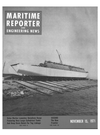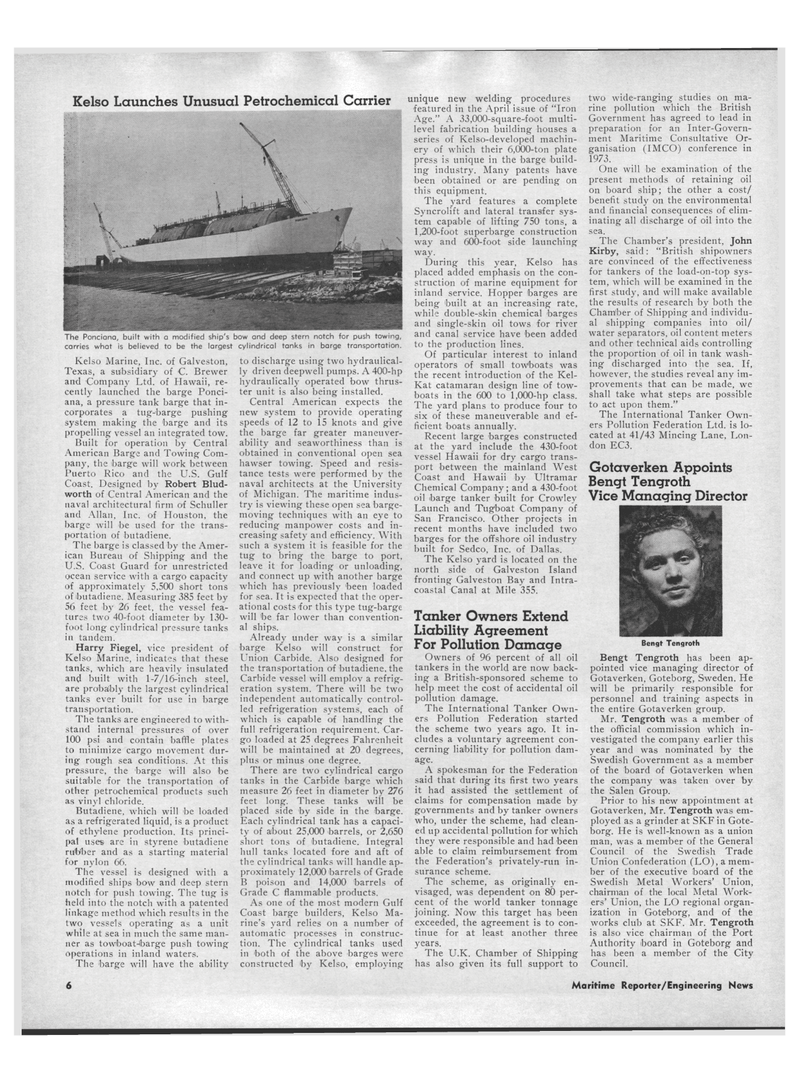
Page 4: of Maritime Reporter Magazine (November 15, 1971)
Read this page in Pdf, Flash or Html5 edition of November 15, 1971 Maritime Reporter Magazine
Kelso Launches Unusual Petrochemical Carrier
The Ponciana, built with a modified ship's bow and deep stern notch for push towing, carries what is believed to be the largest cylindrical tanks in barge transportation.
Kelso Marine, Inc. of Galveston,
Texas, a subsidiary of C. Brewer and Company Ltd. of Hawaii, re- cently launched the barge Ponci- ana, a pressure tank barge that in- corporates a tug-barge pushing system making the 'barge and its propelling vessel an integrated tow.
Built for operation by Central
American Barge and Towing Com- pany, the barge will work between
Puerto Rico and the U.S. Gulf
Coast. Designed by Robert Blud- worth of Central American and the naval architectural firm erf Schuller and Allan, Inc. of Houston, the barge will be used for the trans- portation of butadiene.
The barge is classed by the Amer- ican Bureau of Shipping and the
U.S. Coast Guard for unrestricted ocean service with a cargo capacity of approximately 5,500 short tons of ibutadiene. Measuring 385 feet by 56 feet by 26 feet, the vessel fea- tures two 40-foot diameter by 130- foot long cylindrical pressure tanks in tandem.
Harry Fiegel, vice president of
Kelso Marine, indicates that these tanks, which are heavily insulated and built with 1-7/16-inch steel, are probably the largest cylindrical tanks ever built for use in barge transportation.
The tanks are engineered to with- stand internal pressures of over 100 psi and contain baffle plates to minimize cargo movement dur- ing rough sea conditions. At this pressure, the barge will also be suitable for the transportation of other petrochemical products such as vinyl chloride.
Butadiene, which will be loaded as a refrigerated liquid, is a product of ethylene production. Its princi- pal uses are in styrene butadiene rubber and as a starting material for nylon 66.
The vessel is designed with a modified ships bow and deep stern notch for push towing. The tug is held into the notch with a patented linkage method which results in the two vessels operating as a unit while at sea in much the same man- ner as towboat-barge push towing operations in inland waters.
The barge will have the ability to discharge using two hydraulical- ly driven deepwell pumps. A 400-hp hydraulically operated bow thrus- ter unit is also being installed.
Central American expects the new system to provide operating speeds of 12 to 15 knots and give the barge far greater maneuver- ability and seaworthiness than is obtained in conventional open sea hawser towing. Speed and resis- tance tests were performed by the naval architects at the University of Michigan. The maritime indus- try is viewing these open sea barge- moving techniques with an eye to reducing manpower costs and in- creasing safety and efficiency. With such a system it is feasible for the tug to bring the barge to port, leave it for loading or unloading, and connect up with another barge which has previously 'been loaded for sea. It is expected that the oper- ational costs for this type tug-barge will 'be far lower than convention- al ships.
Already under way is a similar barge Kelso will construct for
Union Carbide. Also designed for the transportation of butadiene, the
Carbide vessel will employ a refrig- eration system. There will be two independent automatically control- led refrigeration systems, each of which is capable of handling the full refrigeration requirement. Car- go loaded at 25 degrees Fahrenheit will be maintained at 20 degrees, plus or minus one degree.
There are two cylindrical cargo tanks in the Carbide barge which measure 26 feet in diameter by 276 feet long. These tanks will be placed side by side in the barge.
Each cylindrical tank has a capaci- ty of about 25,000 barrels, or 2,650 short tons of butadiene. Integral hull tanks located fore and aft of the cylindrical tanks will handle ap- proximately 12,000 barrels of Grade
B poison and 14,000 barrels of
Grade C flammaible products.
As one of the most modern Gulf
Coast barge builders, Kelso Ma- rine's yard relies on a number of automatic processes in construc- tion. The cylindrical tanks used in 'both of the above barges were constructed by Kelso, employing unique new welding procedures featured in the April issue of "Iron
Age." A 33,000-square-foot multi- level fabrication building houses a series of Kelso-developed machin- ery of which their 6,000-ton plate press is unique in the barge build- ing industry. Many patents have been obtained or are pending on this equipment.
The yard features a complete
Syncrolift and lateral transfer sys- tem capable of lifting 750 tons, a 1,200-foot superbarge construction way and 600-foot side launching way.
During this year, Kelso has placed added emphasis on the con- struction of marine equipment for inland service. Hopper barges are being 'built at an increasing rate, while double-skin chemical barges and single-skin oil tows for river and canal service have been added to the production lines.
Of particular interest to inland operators of small towboats was the recent introduction of the Kel-
Kat catamaran design line of tow- boats in the 600 to'l,000-hp class.
The yard plans to produce four to six of these maneuverable and ef- ficient boats annually.
Recent large barges constructed at the yard include the 430-foot vessel Hawaii for dry cargo trans- port between the mainland West
Coast and Hawaii by Ultramar
Chemical Company; and a 430-foot oil barge tanker built for Crowley
Launch and Tugboat Company of
San Francisco. Other projects in recent months have included two barges for the offshore oil industry built for Sedco, Inc. of Dallas.
The Kelso yard is located on the north side of Galveston Island fronting Galveston Bay and Intra- coastal Canal at Mile 355.
Tanker Owners Extend
Liability Agreement
For Pollution Damage
Owners of 96 percent of all oil tankers in the world are now back- ing a British-sponsored scheme to help meet the cost of accidental oil pollution damage.
The International Tanker Own- ers Pollution Federation started the scheme two years ago. It in- cludes a voluntary agreement con- cerning liability for pollution dam- age.
A spokesman for the Federation said that during its first two years it had assisted the settlement of claims for compensation made by governments and by tanker owners who, under the scheme, had clean- ed up accidental pollution for which they were responsible and had been able to claim reimbursement from the Federation's privately-run in- surance scheme.
The scheme, as originally en- visaged, was dependent on 80 per- cent of the world tanker tonnage joining. Now this target has been exceeded, the agreement is to con- tinue for at least another three years.
The U.K. Chamber of Shipping has also given its full support to two wide-ranging studies on ma- rine pollution which the British
Government has agreed to lead in preparation for an Inter-Govern- ment Maritime Consultative Or- ganisation (IMCO) conference in 1973.
One will be examination of the present methods of retaining oil on board ship; the other a cost/ benefit study on the environmental and financial consequences of elim- inating all discharge of oil into the sea.
The Chamber's president, John
Kirby, said: "British shipowners are convinced of the effectiveness for tankers of the load-on-top sys- tem, which will be examined in the first study, and will make available the results of research by both the
Chamber of Shipping and individu- al shipping companies into oil/ water separators, oil content meters and other technical aids controlling the proportion of oil in tank wash- ing discharged into the sea. If, however, the studies reveal any im- provements that can be made, we shall take what steps are possible to act upon them."
The International Tanker Own- ers Pollution Federation Ltd. is lo- cated at 41/43 Mincing Lane, Lon- don EC3.
Gotaverken Appoints
Bengt Tengroth
Vice Managing Director
Bengt Tengroth
Bengt Tengroth has been ap- pointed vice managing director of
Gotaverken, Goteborg, Sweden. He will be primarily responsible for personnel and training aspects in the entire Gotaverken group.
Mr. Tengroth was a member of the official commission which in- vestigated the company earlier this year and was nominated by the
Swedish Government as a member of the board of Gotaverken when the company was taken over by the Salen Group.
Prior to his new appointment at
Gotaverken, Mr. Tengroth was em- ployed as a grinder at SKF in Gote- borg. He is well-known as a union man, was a member of the General
Council of the Swedish Trade
Union Confederation (LO), a mem- ber of the executive board of the
Swedish Metal Workers' Union, chairman of the local Metal Work- ers' Union, the LO regional organ- ization in Goteborg, and of the works club at SKF. Mr. Tengroth is also vice chairman of the Port
Authority board in Goteborg and has been a member of the City
Council. 6 Maritime Reporter/Engineering News

 3
3

 5
5
